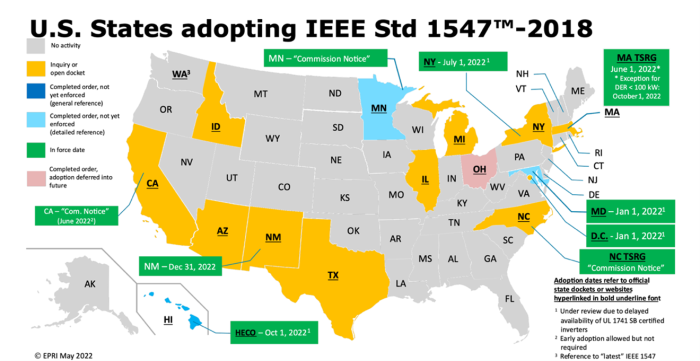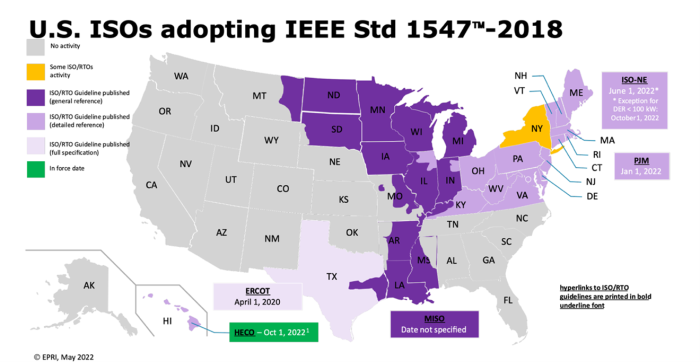
What is IEEE 1547-2018?
IEEE 1547 refers to “Standard 1547” as developed by the Institute of Electrical and Electronics Engineers (IEEE) to safely and functionally integrate distributed energy resources (DERs) into the electric distribution grid. The Energy Policy Act of 2005 established IEEE 1547 as the domestic interconnection standard for DERs.
At a high level, IEEE 1547 can be thought of as the baseline requirements to interconnect a DER with the public utility. The test procedures used to prove compliance with these requirements are outlined in IEEE 1547.1-2020.
The IEEE 1547 standard is continually updated to keep pace with rapidly innovating markets and technologies. The first iteration (IEEE 1547-2003) required DERs to disconnect when the grid was unstable. However, as DER adoption and functionality increased, advanced inverters and batteries became viewed as grid resources that could improve stability while also providing other useful grid services. Accordingly, revisions to the IEEE 1547 standard have been published every few years.
The most recent revision, published in 2018, incorporated “smart inverter” grid support features and interoperability testing to enable remote DER control by utilities.
Examples of inverter-specific functions under the IEEE 1547-2018 standard include:
- Voltage regulation: Maintaining voltage level(s) within a specific range(s) through voltage injection or absorption
- Frequency response: Modulating power output as a function of frequency
- Active and reactive power support: Maintaining a steady power factor by sourcing or sinking reactive power
- Local interoperability capability: Ensuring system-wide protection and control via sophisticated programmable functions and communications that will work even during a network failure
- Ride-through capability: Withstanding abnormal grid conditions such as voltage or frequency disturbances

Not all states have announced their plans for adopting the IEEE 1547-2018 Standard, but many of the biggest markets for solar PV (e.g., California, Texas, New York) either already have established dates or intend to by the end of 2023.
Grid Independent System Operators (ISOs) may also choose to adopt the IEEE 1547-2018 standard. ISOs in the Midwest and Northeast have already introduced guidelines or have plans to do so soon.
What is UL 1741-SB?
Underwriters Laboratories (UL) is an accredited standards developer, tester and certifier in the U.S. and Canada, and acts as an independent third party to verify product or system compliance with IEEE or other industry standards.
UL 1741 is the official industry standard for certification of inverter safety. The tests that an “advanced inverter” must pass to receive UL 1741 certification were designed to meet or exceed the interconnection requirements set by the IEEE 1547-2018 standard and include additional tests for fire and electrical safety.
Since 2017, two major Supplements have been added to the UL 1741 standard: Supplement A (SA) and Supplement B (SB).
UL 1741-SA was published in conjunction with California Rule 21 Phase 1 requirements. These safety tests certify the “smart inverter” grid support functionality needed to modernize the grid through widespread DER integration. The testing requirements for UL 1741-SA are as follows:
- Anti-islanding
- Low/high-voltage ride-through (L/HVRT)
- Low/high-frequency ride-through (L/HFRT)
- Specified power factor (SPF)
- Volt/VAR mode
- Volt/Watt mode
- Frequency/Watt mode
- Ramp rate
UL 1741-SB introduced an interoperability conformance test in accordance with IEEE 1547.1-2020. Conformance can be achieved through either DNP3, IEEE 2030.5, or SunSpec Modbus communications protocols, which are used to store or send information and to control adjustable inverter functions. The testing requirements for UL 1741-SB are more stringent and include the following in addition to the requirements defined above for UL 1741-SA certification:
- Watt/VAR mode
- Voltage magnitude and time trip
- Frequency magnitude and time trip
- EMI
- Surge
- Rate of change of frequency (ROCOF)
- Dynamic voltage support
- Enter service
- Synchronization
- Open phase
- Harmonics
- DC injection
- Ground fault overvoltage (GFOV)
- Load rejection overvoltage (LROV)
- Prioritization of DER responses
- Fault current
- Persistence of DER parameter setting
New grid support functions as defined by Supplements A and B are optional for now but will soon be required in states such as California and Hawaii, with more states expected to follow.
Anton Patton is product management & applications engineering director at CPS America, maker of North America’s top 3-phase string inverter, with over 6 GW shipped in the U.S.
— Solar Builder magazine

Leave a Reply
You must be logged in to post a comment.